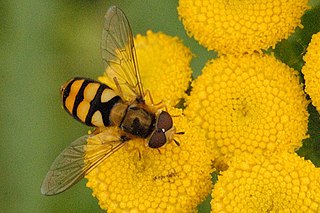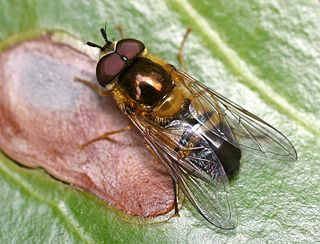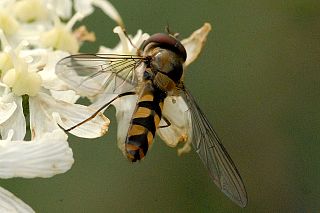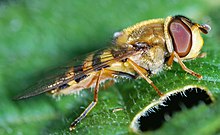
Syrphus ribesii is a very common Holarctic species of hoverfly. Its larvae feed on aphids. In common with many other species of hoverfly, males have the eyes meeting on the top of the head, whilst females have their eyes widely separated.

Leucozona glaucia, the Pale-saddled Leucozona is a Palearctic hoverfly. Larvae feed on ground layer aphids. Adults are usually seen visiting flowers.

Eupeodes corollae is a very common European species of hoverfly. Adults are 6–11 millimetres (0.24–0.43 in) in body length. Males and females have different marking on the abdomen; males have square commas on tergites 3 and 4, whereas females have narrow commas. Larvae feed on aphids. This species has been used experimentally in glasshouses as a method of aphid control, and to control scale insects and aphids in fruit plantations. They were found to be partial to the fruit, eating more fruit than aphids.

Eupeodes luniger is a common species of hoverfly.

Eupeodes latifasciatus is a species of hoverfly. Adults feed on nectar; larvae feed on aphids and scale insects.

Dasysyrphus venustus is a Holarctic species of hoverfly.

Epistrophe eligans is a European species of hoverfly.

Leucozona lucorum is a Palearctic and Nearctic species of hoverfly.

Meliscaeva auricollis is a West Palearctic species of hoverfly.

Meliscaeva cinctella is a Holarctic species of hoverfly.

Xanthandrus comtus is a species of hoverfly. It is found in the Palearctic.

Fagisyrphus cinctus is a European species of hoverfly. This species has a muddled taxonomic history. Older authors treated it as a member of the genus Melangyna, and later sources in Meligramma, but the most recent sources recognize it as the sole species in its own monotypic genus, Fagisyrphus.

Syrphus torvus, the Hairy-eyed Flower Fly, is a common species of hoverfly found in the Holarctic. The adults feed on pollen and nectar, but the larvae feed on aphids.

Epistrophe grossulariae is a Holarctic species of hoverfly.
Heringia heringi is a European species of hoverfly.

Melangyna umbellatarum is a Holarctic species of hoverfly.

Meligramma guttatum is a Holarctic species of hoverfly.

Megasyrphus erraticus is a Holarctic species of hoverfly associated with mature conifer woodlands and plantations.

Didea alneti is a Holarctic species of hoverfly.

Epistrophe nitidicollis is a European and North American species of hoverfly.




















